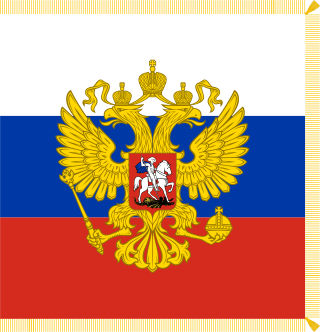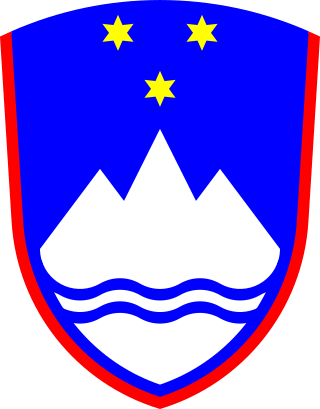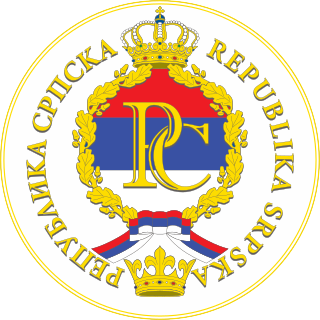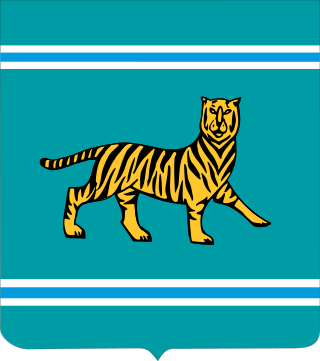
A coat of arms is a heraldic visual design on an escutcheon, surcoat, or tabard. The coat of arms on an escutcheon forms the central element of the full heraldic achievement, which in its whole consists of a shield, supporters, a crest, and a motto. A coat of arms is traditionally unique to the armiger. The term 'coat of arms' itself, describing in modern times just the heraldic design, originates from the description of the entire medieval chainmail 'surcoat' garment used in combat or preparation for the latter.

The national flag of Romania is a tricolour. The Constitution of Romania states that "The flag of Romania is tricolour; the colours are arranged vertically in the following order from the flagpole: blue, yellow, red". The flag has a width-length ratio of 2:3; the proportions, shades of colour as well as the flag protocol were established by law in 1994, and extended in 2001.

The coat of arms of the Philippines features the eight-rayed sun of the Philippines with each ray representing the eight provinces which were placed under martial law by Governor-General Ramón Blanco Sr. during the Philippine Revolution, and the three five-pointed stars representing the three major island groups of Luzon, the Visayas, and Mindanao.

The president of the Russian Federation is the executive head of state of Russia; the president leads the executive branch of the central government of Russia and is the supreme commander-in-chief of the Russian Armed Forces. It is the highest office in Russia.

The national flag of Switzerland displays a white cross in the centre of a square red field. The white cross is known as the Swiss cross or the federal cross. Its arms are equilateral, and their ratio of length to width is 7:6. The size of the cross in relation to the field was set in 2017 as 5:8. Alongside the flag of Vatican City, the Swiss flag is one of only two square national flags in the world.

The national flag of the Russian Federation is a tricolour of three equal horizontal fields: white on the top, blue in the middle, and red on the bottom. It was first raised in 1696, as an ensign for merchant ships under the Tsardom of Russia.

The Constitution of the Russian Federation was adopted by national referendum on 12 December 1993. Russia's constitution came into force on 25 December 1993, at the moment of its official publication, and abolished the Soviet system of government. The current Constitution is the second most long-lived in the history of Russia, behind the Constitution of 1936.

The Slovene coat of arms is an emblem that consists of a red bordered blue shield on which there is a stylised white Mount Triglav, under which there are two wavy lines representing the sea and the rivers of the country. Above Mount Triglav, there are three golden six-pointed stars representing the Counts of Celje. It was designed in 1991 by Marko Pogačnik and adopted on 24 June 1991.

The coat of arms of Russia derives from the earlier coat of arms of the Russian Empire. Though modified more than once since the reign of Ivan III (1462–1505), the current coat of arms is directly derived from its medieval original, with the double-headed eagle having Byzantine and earlier antecedents. The general tincture corresponds to the fifteenth-century standard.

Portuguese heraldry encompasses the modern and historic traditions of heraldry in Portugal and the Portuguese Empire. Portuguese heraldry is part of the larger Iberian tradition of heraldry, one of the major schools of heraldic tradition, and grants coats of arms to individuals, cities, Portuguese colonies, and other institutions. Heraldry has been practiced in Portugal at least since the 12th century, however it only became standardized and popularized in the 16th century, during the reign of King Manuel I of Portugal, who created the first heraldic ordinances in the country. Like in other Iberian heraldic traditions, the use of quartering and augmentations of honor is highly representative of Portuguese heraldry, but unlike in any other Iberian traditions, the use of heraldic crests is highly popular.

The Seal of Republika Srpska with the description: the flag of Republika Srpska and the Cyrillic letters "РС" ("RS"), the red-blue-white tricolor are in the center of the seal, twisted with the golden Oak leaves, a traditional pre-Christian symbol sacred to most Slavs. On the edge of the seal there is an inscription Republika Srpska. The open crown of Kotromanić is shown in the bottom of the seal and the seal itself is topped with a heraldic royal crown.

The coat of arms of the Jewish Autonomous Oblast is the official coat of arms of the Jewish Autonomous Oblast in Russia. The coat of arms consists of an Amur tiger standing on four legs with the tail and the head turned upwards, of which the latter is facing the observer. This specific position and occurrence of the Amur tiger in the coat of arms symbolizes the history and development of the Oblast. The coat is a heraldic French shield and the background represents the color of the geographical characteristics of the Russian Far East; which includes taigas, hills, and meadows.

Socialist-style emblems usually follow a unique style consisting of communist symbolism. Although commonly referred to as coats of arms, most are not actually traditional heraldic achievements. Many communist governments purposely diverged from heraldic tradition in order to distance themselves from the monarchies that they usually replaced, with coats of arms being seen as symbols of the monarchs.

Icelandic heraldry is the study of coats of arms and other insignia used in Iceland. It belongs to the German-Nordic heraldic tradition, as the heraldry of Iceland has been primarily influenced by the heraldic traditions of Norway, Denmark and other Nordic countries. Iceland does not have a strong sense of heraldic tradition, however, because the country lacks a governing body to oversee this. As a result, coats of arms registered as such are virtually nonexistent in modern Iceland. While many municipalities use more or less heraldic logos, there are no heraldic standards to which these must adhere, and they are registered as graphic designs rather than as coats of arms.

Russian heraldry involves the study and use of coats of arms and other heraldic insignia in the country of Russia. Compare the socialist heraldry of the Soviet period of Russian history (1917–1991).

The State Emblem of the Soviet Union was adopted in 1923 and was used until the dissolution of the Soviet Union in 1991. Although it technically is an emblem rather than a coat of arms, since it does not follow traditional heraldic rules, in Russian it is called герб, the word used for a traditional coat of arms.

Throughout the early Middle Ages, the Rurikid knyazes of the Kievan Rus' used unique symbols to denote property rights over various items. They are depicted on punches, seals, and coins of the Rurikids. In contrast to Western European heraldry, where coats of arms belonged to entire families, or were inherited without changes by firstborn sons, Rurikid symbols were personal, with every knyaz devising an emblem of their own for themselves.

The Federal Agency for Tourism (Rostourism) was a federal executive body of the Russian Federation, created by Presidential Decree No. 1453 of November 18, 2004 and dissolved on October 20, 2022. The Federal Agency for Tourism was responsible for rendering state services, managing state property and performing law-enforcement functions in the field of tourism. It was under the direct jurisdiction of the government of Russia. Activities of the Federal Agency for Tourism guided by the Constitution of the Russian Federation, Federal laws, Decrees of the President and the Government of the Russian Federation, and international treaties. The Federal Agency for Tourism carried out its activities in cooperation with other federal executive bodies, executive authorities of the subjects of the Russian Federation, local self-governing bodies, public associations and other organizations. The Federal Agency for Tourism was a legal entity, had a seal with the image of the State Coat of Arms of the Russian Federation and its name, other seals, stamp, and letterhead, as well as bank and other accounts opened. It received funding for its operation and project implementation from the federal budget. The agency head office was in Moscow.

The coat of arms of Nizhny Novgorod is the official symbol of the city from December 20, 2006.

The coat of arms of Sevastopol is a heraldic symbol representing the city of Sevastopol, Crimea. It is featured in the middle of the flag of Sevastopol on a red background.




















